Ministry of New and Renewable Energy
Energy Security in India
प्रविष्टि तिथि:
01 FEB 2025 2:30PM by PIB Delhi
Advancing Renewable Energy and Sustainability through Key Government Initiatives
India's energy security is a cornerstone of its economic and environmental strategy, with a strong push toward renewable energy and self-reliance. As of January 2025, the country’s non-fossil fuel energy capacity has reached 217.62 GW. The CCDC Wind Initiative has significantly enhanced wind energy development, leading to 48.16 GW of installed capacity. The National Green Hydrogen Mission, launched in 2023, is positioning India as a global leader in hydrogen energy with investments exceeding ₹8 lakh crore. The National Solar Mission has propelled solar energy growth, with installed capacity rising from 9.01 GW in 2016 to 97.86 GW in 2025. Additionally, PM-KUSUM and PM Surya Ghar Muft Bijli Yojana are accelerating solar adoption among farmers and households. These efforts, supported by substantial government funding and policy measures, highlight India's commitment to achieving energy security while reducing carbon emissions. By leveraging technological advancements and strategic investments, India is on a path toward a cleaner, more resilient energy future.
Introduction
India's energy security is a critical component of its economic growth and sustainability goals. The government has launched various schemes aimed at promoting renewable energy, enhancing grid stability, and reducing carbon emissions. Key initiatives such as the National Bio Energy Mission, National Green Hydrogen Mission, PM-KUSUM, and PM Surya Ghar Muft Bijli Yojana, reflect the nation's commitment to a cleaner and self-reliant energy future. As of January 2025, India’s total non-fossil fuel-based energy capacity has reached 217.62 GW.
INSTALLED RENEWABLE ENERGY CAPACITY (MW)
|
Sector
|
Cumulative Achievements (till 31.03.2014)
|
2014-15
|
2023-24
|
2024-25 (01.04.2024 – 31.12.2024)
|
Cumulative Achievements (till 31.12.2024)
|
|
Wind Power
|
21,042.58
|
2,311.77
|
3,253.38
|
2,276.65
|
48,163.16
|
|
Solar Power
|
2,821.91
|
1,171.62
|
15,033.24
|
16,051.10
|
97,864.72
|
|
Small Hydro Power
|
3,803.68
|
251.68
|
58.95
|
97.30
|
5,100.55
|
|
Biomass (Bagasse) Cogeneration
|
7,419.23
|
295.67
|
0.00
|
372.86
|
9,806.42
|
|
Biomass (Non-bagasse) Cogeneration
|
531.82
|
60.05
|
107.34
|
0.00
|
921.79
|
|
Waste to Power
|
90.58
|
0.00
|
1.60
|
0.00
|
249.74
|
|
Waste to Energy (Off-grid)
|
139.79
|
9.71
|
30.17
|
34.13
|
370.20
|
|
Total
|
35,849.59
|
4,100.50
|
18,484.68
|
18,832.04
|
162,476.58
|
CCDC Wind Initiative
About the Scheme:
Launched in June 2020, the Centralized Data Collection and Coordination (CCDC) Wind Initiative aims to advance India’s wind energy development by improving wind resource assessment through accurate data collection and research. The initiative provides valuable insights for project developers, helping them identify the most promising locations for wind energy projects. It supports the efficient implementation of large-scale wind energy projects and encourages investments in the wind sector. The Government, through National Institute of Wind Energy (NIWE), has installed over 800 wind-monitoring stations all over country and issued wind potential maps at 50m, 80m and 100m above ground level. As on 30 January 2024, India's cumulative wind power capacity stands at 48.16 GW.
Objective:
- Facilitate wind energy development through centralized data collection and research.
- Provide accurate wind resource assessment for better site identification.
- Promote private sector investments and public-private partnerships in wind energy projects.
Key Achievements:
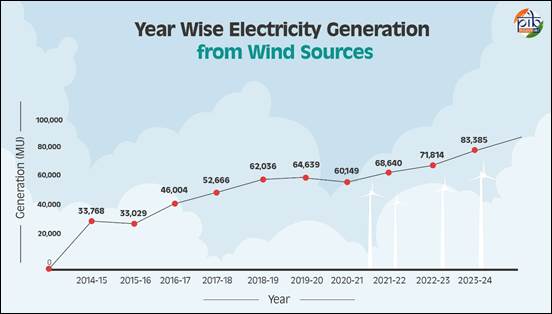
- Enhanced wind resource mapping has contributed to the successful identification of over 50 potential wind energy sites nationwide.
- Contributed to the development of over 10 GW of new wind energy capacity from 2020-2024, increasing India's wind energy capacity by 30%.
- Significant growth in wind energy capacity, from 1.86 GW in March 2004 and 21.04 GW in December 2014 to 48.16 GW in January 2025, reflecting the initiative's impact.
- In 2024, the Union Cabinet approved a Rs. 7,453 crore Viability Gap Funding (VGF) scheme to set up India’s first offshore wind energy projects. The scheme includes Rs. 6,853 crores for 1 GW of offshore wind capacity (500 MW each off the coasts of Gujarat and Tamil Nadu) and Rs. 600 crores for port upgrades to support logistics for these projects.
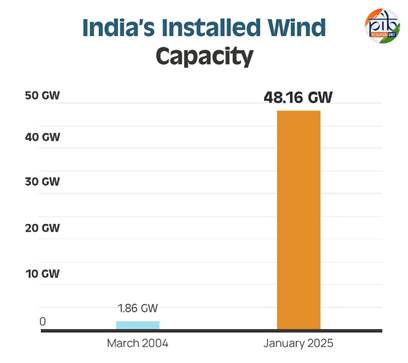
National Green Hydrogen Mission
About the Scheme:
Launched in January 2023, the National Green Hydrogen Mission is an ambitious initiative aimed at transitioning India towards a hydrogen-based economy. The scheme focuses on the development of indigenous technology for green hydrogen production, infrastructure for storage, transportation, and utilization. By promoting hydrogen as a clean energy source, the mission aims to position India as a global leader in green hydrogen production and export, thereby driving sustainability and reducing dependence on fossil fuels. With over Rs. 8 lakh crores in total investments, green hydrogen capacity is expected to reach 5 million metric tons by 2030. This is expected to create 6 lakh jobs by 2030.
Objective:
- Making India a leading producer and supplier of Green Hydrogen in the world.
- Creation of export opportunities for Green Hydrogen and its derivatives.
- Reduction in dependence on imported fossil fuels and feedstock.
- Development of indigenous manufacturing capabilities.
- Attracting investment and business opportunities for the industry.
- Creating opportunities for employment and economic development.
- Supporting R&D projects.
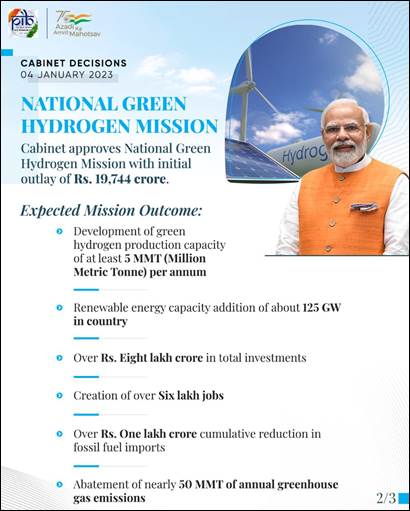
Key Achievements:
- ₹19,744 crore allocated for the mission's implementation, with a focus on infrastructure development and technology innovation. The Mission has an outlay of ₹600 crore for FY 2024-25.
- Establishment of 3 hydrogen production hubs in key locations across the country.
- Tenders awarded to companies for 4.12 lakh tonnes per annum green hydrogen production.
- Development of key policies and financial incentives, with 50% subsidy on electrolyser manufacturing and hydrogen production. Selection of manufacturers for 1,500 MW electrolyser capacity was also conducted in 2024.
- The International Conference on Green Hydrogen (ICGH – 2023) took place in New Delhi from 5th to 7th July, 2023, featuring global participation from industry, academia, and government.
- From 18th to 22nd March, 2024, India hosted the 41st International Partnership for Hydrogen and Fuel Cells in the Economy (IPHE) Meeting in New Delhi, fostering collaboration on clean hydrogen technologies.
- From September 11-13, 2024, the 2nd International Conference on Green Hydrogen (ICGH) in New Delhi emphasized advancements in green hydrogen technology and India's leadership in the sector.
- The year 2024 also witnessed India's innovative renewable energy solutions being showcased on international platforms such as the World Hydrogen Summit 2024 in Rotterdam, Netherlands.
National Solar Mission (NSM)
About the Scheme:
Launched in January 2010, NSM is a major initiative to promote ecological sustainable growth while addressing India’s energy security challenges. It is also a major contribution by India to the global effort to meet the challenges of climate change. In order to achieve the above target, Government of India have launched various schemes to encourage generation of solar power in the country like Solar Park Scheme, VGF Schemes, CPSU Scheme, Defence Scheme, Canal bank & Canal top Scheme, Bundling Scheme, Grid Connected Solar Rooftop Scheme etc.
Objectives:
- Establish India as a global leader in solar energy by creating the policy conditions for solar technology diffusion across the country as quickly as possible.
- Achieve the Nationally Determined Contributions (NDCs) target to achieve about 50 percent cumulative electric power installed capacity from non-fossil fuel-based energy resources and to reduce the emission intensity of its GDP by 45 percent from 2005 level by 2030.
Off-Grid Solar PV Programme:
Off-grid Solar PV Applications Programme is one of the oldest programmes of the Ministry aimed at providing solar PV-based applications in areas where grid power is either not available or is unreliable. Applications such as solar home lighting systems, solar street lighting systems, solar power plants, solar pumps, solar lanterns and solar study lamps are covered under the programme.
Solar Grid Connected Programme:
Government of India have launched various schemes to encourage generation of solar power in the country like Solar Park Scheme, VGF Schemes, CPSU Scheme, Defence Scheme, Canal bank & Canal top Scheme, Bundling Scheme, Grid Connected Solar Rooftop Scheme etc. Various policy measures are also undertaken to promote the grid connected solar power plants. By 2023, India achieved 5th rank in the world in solar power deployment.
Key Achievements:
|
Parameter
|
2016
(By March 2016)
|
2024
(By March 2024)
|
|
Total Installed Solar Capacity
|
9.01 GW
|
*96.86 GW
|
|
Number of Solar Parks
|
34
|
58
|
|
Total Capacity of Solar Parks
|
20 GW
|
40 GW
|
|
Rooftop Solar Capacity
|
90.8 MV
|
11,503 MV
|
|
Number of Solar Home Lights
|
13.96 lakh
|
17.23 lakh
|
|
Number of Solar Street Lights
|
4.42 lakh
|
9.44 lakh
|
|
Installed Capacity of Power Plants
|
172.45 GW
|
216.86 GW
|
- In March 2016, the total installed solar capacity was 9.01 GW and by March 2024, the total installed solar capacity stood at 81.81 GW. *As of 28 January 2025, the total installed solar capacity is 97.86 GW.
- As of March 2024, the total estimated solar potential of the country stood at 748.98 GW.
- As of March 2024, there are a total of 58 solar parks in India with a sanctioned capacity of 40 GW, in contrast to March 2016, when there were only 34 solar parks with 20 GW sanctioned capacity.
- In March 2016, there was only 90.8 MV installed solar capacity under the Rooftop PV and Small Solar Power Generation Programme (RPSSGP). In March 2024, the total installed capacity has reached 11,503 MV.
- In 2024, for off-grid projects, India has 17.23 lakh solar home lights, 84.59 solar lamps, 9.44 lakh solar street lights and an installed capacity of 216.86 GW from solar power plants. This has increased from 2016, when 13.96 lakh solar home lights, 4.42 lakh solar street lights and 172.45 GW of installed solar capacity from power plants.
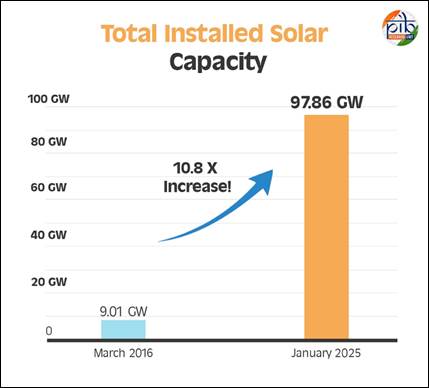
PM-KUSUM Scheme: (Pradhan Mantri Kisan Urja Suraksha evam Utthaan Mahabhiyan)
About the Scheme:
Launched in March 2019, the PM-KUSUM Scheme supports farmers by offering financial assistance for installing solar-powered irrigation systems, including solar pumps and grid-connected solar power plants. By shifting to solar energy, the scheme also helps to reduce carbon emissions and improve energy access in rural agricultural areas. Under the Scheme, central government subsidy upto 30% or 50% of the total cost is given for the installation of standalone solar pumps and for the solarization of existing grid-connected agricultural pumps.

Objective:
- Promote solar energy adoption among farmers by subsidizing solar-powered irrigation.
- Reduce dependency on diesel pumps, leading to lower fuel costs and improve energy access in rural agricultural areas.
- Enhance income generation through surplus solar energy sales.

Key Achievements:
- Over 6.1 lakh solar pumps installed nationwide by December 2024, as compared to 3.3 lakh solar pumps installed by December 2021.
- 35 lakh grid-connected agriculture pumps solarized.
- As of June 2024, more than 4 lakh farmers nationwide have benefited from the PM-KUSUM scheme.
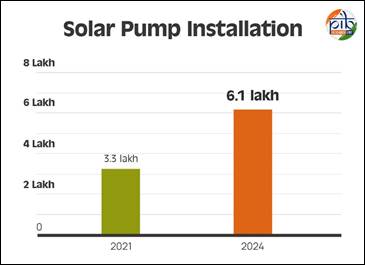
- Under Components B and C of PM-KUSUM: 30% CFA provided (or 50% for North Eastern/Hilly regions/Islands) for installing standalone agriculture pumps and solarizing grid-connected pumps.
- About 11.34 GW of solar energy capacity has been installed during January to November 2024.
PM Surya Ghar Muft Bijli Yojana
About the Scheme:
Launched in February 2024, the PM Surya Ghar Muft Bijli Yojana, the world’s largest domestic rooftop solar initiative, is designed to promote rooftop solar energy adoption in residential areas. By providing financial incentives and subsidies for solar panel installation, the scheme enables households to generate their electricity, reducing their dependence on the national grid and lowering electricity bills. The initiative has a bold vision to supply solar power to one crore households by March 2027.
Objective:
- Encourage rooftop solar adoption in residential sectors.
- Provide financial incentives and subsidies for solar panel installation.
- Enable households to generate their own electricity, reducing dependency on the grid.
- Reduce electricity bills by allowing households to generate and sell surplus solar energy to the grid.
Key Achievements:
- Increased participation in the distributed solar energy ecosystem, with over 1 lakh homes installing rooftop panels in the first year.
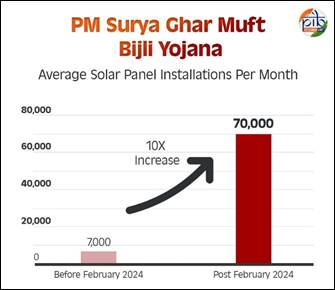
- Households benefiting from 20-30% reduction in electricity bills due to self-generated solar power.
- Within just 10 months of PMSGMBY, 7 lakh installations have been achieved—an average of 70,000 per month. This marks a ten-fold increase in monthly installations compared to the average of 7,000 per month prior to the launch of the scheme in February 2024.
- States such as Gujarat, Maharashtra, Kerala, and Uttar Pradesh have demonstrated exceptional progress, reflecting robust infrastructure and stakeholder collaboration.
- Issuance of Operational Guidelines for the 'Model Solar Village' scheme, with a total outlay of ₹800 crore, granting ₹1 crore grant for the winning village in each district. It aims to promote solar energy adoption and make villages self-reliant in energy. Villages with populations over 5,000 (or 2,000 in special states) can compete based on their renewable energy capacity.
References
MNRE Annual Reports (2016-2024)
https://npp.gov.in/dashBoard/cp-map-dashboard
https://mnre.gov.in/en/year-wise-achievement/#
https://www.india.gov.in/spotlight/national-green-hydrogen-mission
https://mnre.gov.in/en/national-green-hydrogen-mission/
https://pib.gov.in/PressNoteDetails.aspx?NoteId=151902
https://pib.gov.in/PressReleaseIframePage.aspx?PRID=2089056
https://ccdcwind.gov.in/potential_of_wind_energy_in_india.html
https://cdnbbsr.s3waas.gov.in/s3716e1b8c6cd17b771da77391355749f3/uploads/2024/05/20240524405410771.pdf
https://cdnbbsr.s3waas.gov.in/s3716e1b8c6cd17b771da77391355749f3/uploads/2023/08/2023080324.pdf
https://cdnbbsr.s3waas.gov.in/s3716e1b8c6cd17b771da77391355749f3/uploads/2024/10/20241029512325464.pdf
https://pib.gov.in/PressReleaseIframePage.aspx?PRID=2094992
https://pib.gov.in/PressReleaseIframePage.aspx?PRID=1943905
https://mnre.gov.in/en/bio-gas/
https://pmkusum.mnre.gov.in/
https://pib.gov.in/PressReleaseIframePage.aspx?PRID=2081250
https://www.pmsuryaghar.gov.in/
https://cag.gov.in/uploads/download_audit_report/2015/Union_Civil_Performance_Renewable_Energy_Report_34_2015_chap_8.pdf
https://powermin.gov.in/sites/default/files/uploads/ar03_04.pdf
Click here to download PDF
*****
Santosh Kumar | Sarla Meena | Rishita Aggarwal
(रिलीज़ आईडी: 2098441)
आगंतुक पटल : 12400